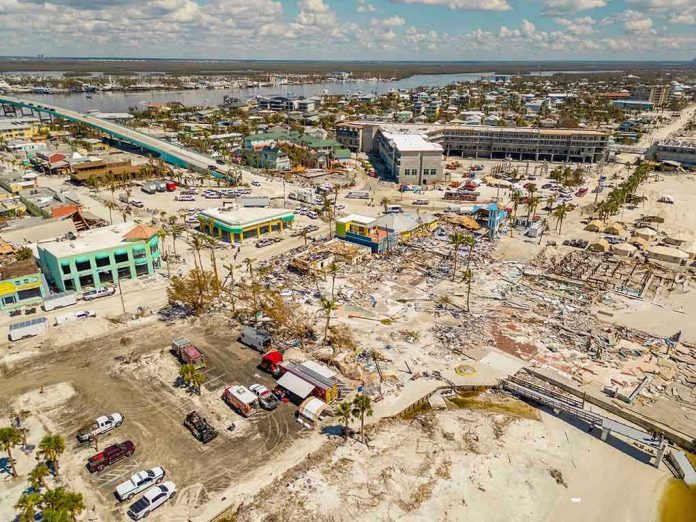
When the wind howls and the water rises, the small decisions you make before, during, and after a hurricane often mark the difference between safety and catastrophe—sometimes in ways you won’t see coming until it’s too late.
Quick Take
- Personal preparedness, not luck, is the true lifesaver before, during, and after a hurricane
- Official guidance now prioritizes vulnerable populations, from the medically dependent to pet owners
- Technology and real-time alerts have changed the rules for evacuation and response
- The aftermath poses invisible dangers—from contaminated water to chronic stress—that can outlast the storm
Preparation: The First Line of Defense Against Disaster
Every hurricane season, government agencies and weather experts repeat the mantra: preparation is survival. The reality is starker—without knowing your evacuation zone, setting a destination in advance, and keeping a go-kit ready, you risk being caught in a scramble when roads are choked and stores are empty. Emergency kits aren’t just for doomsday preppers anymore. They’re for anyone who wants to avoid the panic that comes with empty gas tanks, dead batteries, or a lack of medication when pharmacies and hospitals shut down. The American Red Cross and FEMA stress that updating your emergency plan every year, and practicing it with family—including pets—has moved from suggestion to necessity for those in hurricane-prone regions. If you own a home, fortification isn’t a one-time project. Boarding up windows, securing outdoor items, and trimming trees are simple steps that insurance claims and news footage prove again and again can prevent injuries and limit property loss. Yet, the biggest shift in recent years is information: real-time alerts and evacuation orders now come by text, app, and social media. The gap between warning and impact has shrunk, and the margin for error is razor thin.
Vulnerable groups—elderly, disabled, medically dependent—face additional hurdles. If you or a loved one falls into these categories, advanced planning for transport, backup power for medical devices, and pre-registration with local emergency shelters is critical. The chaos of evacuation is not the time to learn about special needs shelters or to discover that pets aren’t allowed in standard facilities. These are details that separate inconvenience from tragedy.
During the Storm: Sheltering Smart and Staying Alive
Once hurricane-force winds arrive, the rules change and the outside world is no longer an option. Safety becomes a matter of staying put—ideally in a windowless, interior room on the lowest floor that isn’t prone to flooding. Emergency broadcasts and alerts become your lifeline, not background noise. Authorities warn against venturing out, even between lulls in the storm, as flying debris and sudden surges can turn the streets deadly in seconds. Power outages and water disruptions are the norm, not the exception, so reliance on flashlights, battery radios, and pre-stocked water is non-negotiable. If you think you can drive out, think again. Emergency crews will not risk their lives for avoidable rescues once conditions deteriorate. The collective wisdom from past disasters is blunt: the safest place is indoors, away from windows, until officials declare the danger has passed.
Families with special health needs should have not just backup medication, but a plan for refrigeration and care—hospitals and pharmacies may be inaccessible for days. For pet owners, safe sheltering inside the home is essential; animals are often lost or injured when left outside or abandoned in the rush.
The Aftermath: Hidden Hazards and the Long Road to Recovery
Surviving the hurricane is only half the battle. Many fatalities and injuries occur in the storm’s wake, when hazards multiply and vigilance fades. Authorities stress: do not return home until officials give the all-clear. Floodwaters may hide live electrical wires, sewage, or dangerous debris. CDC guidance is unequivocal: avoid floodwater contact, wear protective gear during cleanup, and never use generators or grills indoors—carbon monoxide poisoning remains a leading cause of post-hurricane deaths. Downed power lines, gas leaks, and unstable structures linger long after the sky clears.
The emotional toll is profound. Many experience anxiety, depression, or trauma in the days and weeks after the event. Mental health support is no longer an afterthought; it’s a vital part of recovery, as isolation and loss can linger long after physical wounds heal. Community resources, and reaching out to neighbors, help restore normalcy and resilience in the face of devastation.
Lessons from Past Storms: Why Today’s Protocols Matter
Hurricane Katrina and Hurricane Maria rewrote the manual for disaster response. The images of stranded families and collapsed infrastructure forced a reckoning: waiting for help is not a plan. Federal, state, and nonprofit organizations now operate with tighter coordination, but they emphasize that every household is its own first responder for the first 72 hours. Insurance companies, construction crews, and local governments all play a role, but the initial burden falls on individuals and communities to act before rescue is possible. Preparedness is not just about survival—it’s about mitigating long-term disruption, economic loss, and the health impacts that ripple long after the storm passes.
The most current guidance from the Red Cross, CDC, FEMA, and state authorities agrees: know your risks, update your plan, and never underestimate the aftermath. Hurricanes expose the weak links in every chain—from government response to personal resolve. Those who plan, adapt, and stay alert are the ones who weather the storm and emerge stronger on the other side.
Sources:
American Red Cross: Hurricane Safety
NEEF: Hurricane Preparedness During and After
Massachusetts: Hurricane Safety Tips



